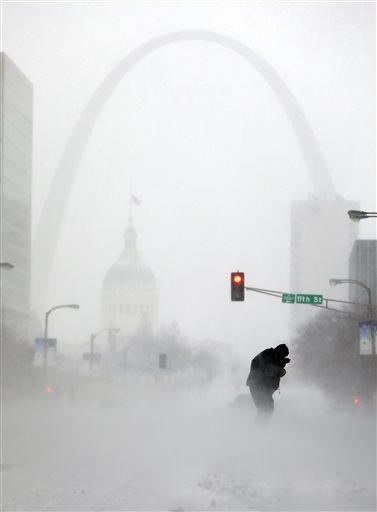WASHINGTON (AP) — We’ve become weather wimps.
As the world warms, the United States is getting fewer bitter cold spells like the one that gripped much of the nation this week. So when a deep freeze strikes, scientists say, it seems more unprecedented than it really is. An Associated Press analysis of the daily national winter temperature shows that cold extremes have happened about once every four years since 1900.

Until recently.
When computer models estimated that the national average daily temperature for the Lower 48 states dropped to 17.9 degrees on Monday, it was the first deep freeze of that magnitude in 17 years, according to Greg Carbin, warning meteorologist for the National Oceanic and Atmospheric Administration.
That stretch – from Jan. 13, 1997 to Monday – is by far the longest the U.S. has gone without the national average plunging below 18 degrees, according to a database of daytime winter temperatures starting in January 1900.
In the past 115 years, there have been 58 days when the national average temperature dropped below 18. Carbin said those occurrences often happen in periods that last several days so it makes more sense to talk about cold outbreaks instead of cold days. There have been 27 distinct cold snaps.
Between 1970 and 1989, a dozen such events occurred, but there were only two in the 1990s and then none until Monday.
“These types of events have actually become more infrequent than they were in the past,” said Carbin, who works at the Storm Prediction Center in Norman, Okla. “This is why there was such a big buzz because people have such short memories.”
Said Jeff Masters, meteorology director of the private firm Weather Underground: “It’s become a lot harder to get these extreme (cold) outbreaks in a planet that’s warming.”
And Monday’s breathtaking chill? It was merely the 55th coldest day – averaged for the continental United States – since 1900.
The coldest day for the Lower 48 since 1900 – as calculated by the computer models – was 12 degrees on Christmas Eve 1983, nearly 6 degrees chillier than Monday.
The average daytime winter temperature is about 33 degrees, according to Carbin’s database.
There have been far more unusually warm winter days in the U.S. than unusually cold ones.
Since Jan. 1, 2000, only two days have ranked in the top 100 coldest: Monday and Tuesday. But there have been 13 in the top 100 warmest winter days, including the warmest since 1900: Dec. 3, 2012. And that pattern is exactly what climate scientists have been saying for years, that the world will get more warm extremes and fewer cold extremes.
Nine of 11 outside climate scientists and meteorologists who reviewed the data for the AP said it showed that as the world warms from heat-trapping gas spewed by the burning of fossil fuels, winters are becoming milder. The world is getting more warm extremes and fewer cold extremes, they said.
“We expect to see a lengthening of time between cold air outbreaks due to a warming climate, but 17 years between outbreaks is probably partially due to an unusual amount of natural variability,” or luck, Masters said in an email. “I expect we’ll go far fewer than 17 years before seeing the next cold air outbreak of this intensity.
And the scientists dismiss global warming skeptics who claim one or two cold days somehow disproves climate change.
“When your hands are freezing off trying to scrape the ice off your car, it can be all too tempting to say, `Where’s global warming now? I could use a little of that!’ But you know what? It’s not as cold as it used to be anymore,” Texas Tech University climate scientist Katharine Hayhoe said in an email.
The recent cold spell, which was triggered by a frigid air mass known as the polar vortex that wandered way south of normal, could also be related to a relatively new theory that may prove a weather wild card, said Rutgers University climate scientist Jennifer Francis. Her theory, which has divided mainstream climate scientists, says that melting Arctic sea ice is changing polar weather, moving the jet stream and causing “more weirdness.”
Ryan Maue, a meteorologist with the private firm Weather Bell Analytics who is skeptical about blaming global warming for weather extremes, dismisses Francis’ theory and said he has concerns about the accuracy of Carbin’s database. Maue has his own daily U.S. average temperature showing that Monday was colder than Carbin’s calculations.
Still, he acknowledged that cold nationwide temperatures “occurred with more regularity in the past.”
Many climate scientists say Americans are weather weenies who forgot what a truly cold winter is like.
“I think that people’s memory about climate is really terrible,” Texas A&M University climate scientist Andrew Dessler wrote in an email. “So I think this cold event feels more extreme than it actually is because we’re just not used to really cold winters anymore.”
—
Seth Borenstein can be followed at http://twitter.com/borenbears .





